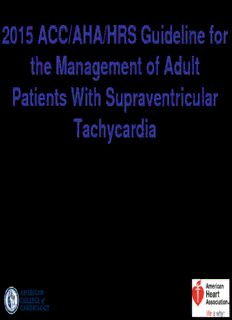
2015 ACC/AHA/HRS Guideline for the Management of Adult PDF
Preview 2015 ACC/AHA/HRS Guideline for the Management of Adult
2015 ACC/AHA/HRS Guideline for the Management of Adult Patients With Supraventricular Tachycardia Developed in Partnership with the Heart Rhythm Society © American College of Cardiology Foundation and American Heart Association Citation This slide set is adapted from the 2015 ACC/AHA/HRS Guideline for the Management of Adult Patients With Supraventricular Tachycardia. Published on September 23, 2015, available at: Journal of the American College of Cardiology [http://content.onlinejacc.org/article.aspx?doi=10.1016/j.jacc.2015.08.856] and Circulation [http://circ.ahajournals.org/lookup/doi/10.1161/CIR.0000000000000311] The full-text guidelines are also available on the following Web sites: ACC (www.acc.org) and AHA (my.americanheart.org) 2015 ACC/AHA/HRS SVT Guideline Writing Committee Richard L. Page, MD, FACC, FAHA, FHRS, Chair José A. Joglar, MD, FACC, FAHA, FHRS, Vice Chair Stephen C. Hammill, MD, FACC, FHRS‡ Mary A. Caldwell, RN, MBA, PhD, FAHA Julia H. Indik, MD, PhD, FACC, FAHA, Hugh Calkins, MD, FACC, FAHA, FHRS*‡ FHRS‡ Jamie B. Conti, MD, FACC*†§ Bruce D. Lindsay, MD, FACC, FHRS*‡ Barbara J. Deal, MD† Brian Olshansky, MD, FACC, FAHA, FHRS*† N.A. Mark Estes III, MD, FACC, FAHA, Andrea M. Russo, MD, FACC, FHRS*§ FHRS*† Win-Kuang Shen, MD, FACC, FAHA, FHRS║ Michael E. Field, MD, FACC, FHRS† Cynthia M. Tracy, MD, FACC† Zachary D. Goldberger, MD, MS, FACC, FAHA, FHRS† Sana M. Al-Khatib, MD, MHS, FACC, FAHA, FHRS, Evidence Review Committee Chair† †ACC/AHA Representative. ‡HRS Representative. §ACC/AHA Task Force on Performance Measures Liaison. ║ACC/AHA Task Force on Clinical Practice Guidelines Liaison. Scope of the Guideline • Supersedes the “2003 ACC/AHA/ESC Guideline for the Management of Patients with Supraventricular Arrhythmias” • Addresses regular as well as irregular SVT (such as atrial flutter with irregular ventricular response and multifocal atrial tachycardia) but does not include atrial fibrillation • Aimed at the adult population (>18 years of age) and gives no specific recommendations for pediatric patients • Emphasizes shared decision making with the patient whenever possible Table 1. Applying Class of Recommendation and Level of Evidence Differential Diagnosis for Adult Narrow QRS Tachycardia Narrow QRS tachycardia Patients with junctional (QRS duration <120 ms) tachycardia may mimic the pattern of slow-fast AVNRT and may show AV dissociation and/or Regular marked irregularity in the tachycardia junctional rate. Yes No *RP refers to the interval from the onset of surface QRS to the AAttrriiaall ffiibbrriillllaattiioonn,, onset of visible P wave (note that Visible AAttrriiaall ttaacchhyyccaarrddiiaa//fflluutttteerr wwiitthh P waves vvaarriiaabbllee AAVV ccoonndduuccttiioonn,, the 90-ms interval is defined from MMAATT the surface ECG, as opposed to the 70-ms ventriculoatrial interval Yes No that is used for intracardiac AVNRT or other diagnosis). mechanism with Atrial rate P waves not greater than identified AV indicates atrioventricular; ventricular rate AVNRT, atrioventricular nodal reentrant tachycardia; AVRT, Yes No atrioventricular reentrant tachycardia; ECG, Atrial flutter or RP interval short Atrial tachycardia (RP <PR) electrocardiogram; MAT, multifocal atrial tachycardia; and Yes No (RP >PR) PJRT, permanent form of junctional reentrant tachycardia. RP <90* ms Atrial tachycardia, Modified with permission from PJRT, or Atypical AVNRT Blomström-Lundqvist et al. Yes No AVRT, AVNRT Atypical AVNRT, or Atrial tachycardia 2015 ACC/AHA/HRS SVT Guideline General Principles Principles of Medical Therapy Acute Treatment Principles of Medical Therapy – Acute Treatment COR LOE Recommendations Vagal maneuvers are recommended for acute I B-R treatment in patients with regular SVT. Adenosine is recommended for acute treatment in I B-R patients with regular SVT. Synchronized cardioversion is recommended for acute treatment in patients with hemodynamically I B-NR unstable SVT when vagal maneuvers or adenosine are ineffective or not feasible. Synchronized cardioversion is recommended for acute treatment in patients with hemodynamically I B-NR stable SVT when pharmacological therapy is ineffective or contraindicated. Principles of Medical Therapy – Acute Treatment (cont’d) COR LOE Recommendations Intravenous diltiazem or verapamil can be IIa B-R effective for acute treatment in patients with hemodynamically stable SVT. Intravenous beta blockers are reasonable for IIa C-LD acute treatment in patients with hemodynamically stable SVT.
Description: